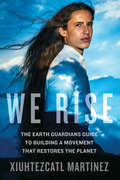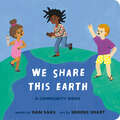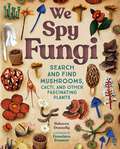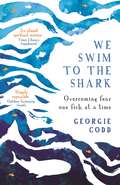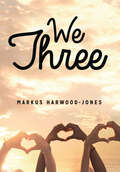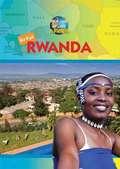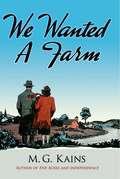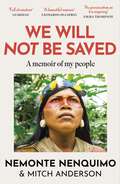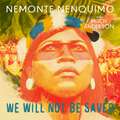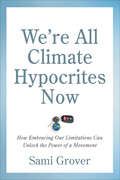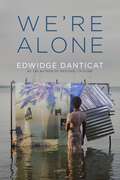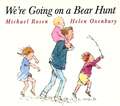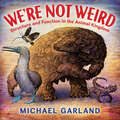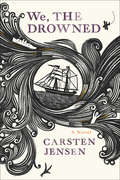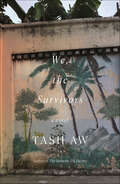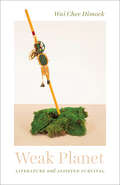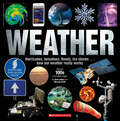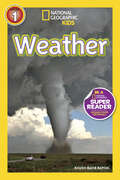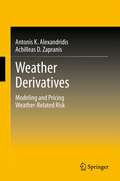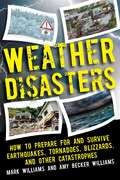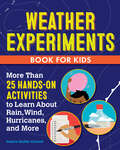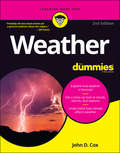- Table View
- List View
We Rise: The Earth Guardians Guide to Building a Movement that Restores the Planet
by Xiuhtezcatl MartinezChallenge the status quo, change the face of activism, and confront climate change head on with the ultimate blueprint for taking action.Xiuhtezcatl Martinez is a 16-year-old climate activist, hip-hop artist, and powerful new voice on the frontlines of a global youth-led movement. He and his group the Earth Guardians believe that today’s youth will play an important role in shaping our future. They know that the choices made right now will have a lasting impact on the world of tomorrow, and people—young and old—are asking themselves what they can do to ensure a positive, just, and sustainable future. We Rise tells these stories and addresses the solutions.Beginning with the empowering story of the Earth Guardians and how Xiuhtezcatl has become a voice for his generation, We Rise explores many aspects of effective activism and provides step-by-step information on how to start and join solution-oriented movements. With conversations between Xiuhtezcatl and well-known activists, revolutionaries, and celebrities, practical advice for living a more sustainable lifestyle, and ideas and tools for building resilient communities, We Rise is an action guide on how to face the biggest problems of today, including climate change, fossil fuel extraction, and industrial agriculture.If you are interested in creating real and tangible change, We Rise will give you the inspiration and information you need to do your part in making the world a better place and leave you asking, What kind of legacy do I want to leave?
We Share This Earth: A Community Book (Community Books)
by Dan SaksA rhyming, heartfelt celebration of the worldwide community and the vital role it plays in young children&’s lives.This formative board book is an appreciation of our global community and the many ways in which it helps develop empathy, compassion, and collective responsibility. Specific examples of shared community are depicted across twelve countries, inviting young readers to connect with and acknowledge the importance of caring about and for one another, and the Earth we share.
We Spy Fungi: Search and Find Mushrooms, Cacti, and Other Fascinating Plants
by Rebecca DonnellyPlants that look like rocks! A fungus that looks like a nest! It’s a weird world out there, and you’ll find some of the weirdest plants and fungi in this book! From South America to South Africa and across the United States, fascinating fungi and peculiar plants are waiting for you to find them. Visit a cloud forest, desert, tundra, and more on your quest. Read the clues carefully and keep your eyes open. When you’ve spotted the plant or fungus that matches the clue, turn the page and read more eye-popping facts. You’ll learn about the natural wonders that live alongside them, too, including insects, birds, mammals, and fish. Are you ready? Get out there and see what there is to see!
We Swim to the Shark: Overcoming fear one fish at a time
by Georgie CoddGeorgie Codd is scared of fish. Really, really scared.Loving the sea and resenting her phobia, she plots to cross continents, learn to dive and swim with the world's biggest fish: the mighty whale shark.Georgie soon plunges into a realm of strange creatures and intrepid diving adventurers. But as her quest to fight fear expands over oceans, the shark remains elusive, and everything else starts to fall apart around her.'We Swim to the Shark is a lesson in not giving up . . . as with all good adventure stories, the real benefit is in the searching' THE I'An almost spiritual mission' TIMES LITERARY SUPPLEMENT 'A terrific read' BBC RADIO NORFOLK 'An enthralling ride' ABC MELBOURNE
We Swim to the Shark: Overcoming fear one fish at a time
by Georgie CoddGeorgie Codd is scared of fish. Really, really scared.Loving the sea and resenting her phobia, she plots to cross continents, learn to dive and swim with the world's biggest fish: the mighty whale shark.Georgie soon plunges into a realm of strange creatures and intrepid diving adventurers. But as her quest to fight fear expands over oceans, the shark remains elusive, and everything else starts to fall apart around her.'We Swim to the Shark is a lesson in not giving up . . . as with all good adventure stories, the real benefit is in the searching' THE I'An almost spiritual mission' TIMES LITERARY SUPPLEMENT 'A terrific read' BBC RADIO NORFOLK 'An enthralling ride' ABC MELBOURNE
We Three (Lorimer Real Love)
by Markus Harwood-JonesJasbina "Jassie" Dhillon is at summer camp to address concerns over her struggles at school and her lack of close friends. To Jasbina's surprise, she quickly makes two new friends, Ams and Sydney. Jassie realizes she has romantic feelings for both of them, and is upset until Ams and Syd tell Jassie they want to be with her too. The three spend their time at camp working out their relationship. As camp gets close to ending, Syd proposes that they run away together. Ams feels they should just end their relationship. In this high-low YA romance, Jassie must find the courage to convince her partners that their love can survive in the real world. Distributed in the U.S by Lerner Publishing Group
We Took to the Woods
by Louise Dickinson RichMrs. Louise Dickenson Rich lives in very rural Maine in the 1940s. She tells about her life, having to stock up on canned goods for the winter, their fresh meat is when her husband hunts. She tells of her life and loving it, but what happens when she realizes that she is out of touch with life such as technology, life, movies, stores...
We Visit Rwanda
by John BankstonThe Great Lakes Region of Central Africa has been called paradise. Most of the region is over 3,200 feet (975 meters) above sea level. The mosquitoes and tsetse flies plaguing much of the continent rarely fly so high. Winds crisscrossing the region are damp, carrying moisture from low-lying clouds.
We Wanted a Farm
by Maurice KainsIn his classic Five Acres and Independence, Maurice G. Kains offered advice about living off the land with privately raised stock and produce. In this engaging and informative memoir, he relates his family's experiences in realizing their long-cherished dream—establishing and maintaining their own small farm. Kains recounts how they overcame the handicap of unproductive clay soil to develop a relatively small garden that yielded an entire year's supply of vegetables. He describes his reclamation of neglected fruit trees, vines, and blackberry patches; laying out an orchard of 1,000 trees, a vineyard, a commercial vegetable garden, and ornamental plantings; the installation of heating, water, and sewage systems; fighting weeds and bugs; and numerous other challenges. Gardeners, urban homesteaders, those who aspire to life on a small working farm, and other readers will find We Wanted a Farm an outstanding and informative source of expert advice.
We Will Not Be Saved: A memoir of hope and resistance in the Amazon rainforest
by Nemonte Nenquimo'Nemonte's writing is as provocative as it is inspiring' EMMA THOMPSON'One of the most effective leaders for indigenous rights and environmental justice' LAURENE POWELL JOBS'I'm here to tell you my story, which is also the story of my people and the story of this forest.'Born into the Waorani tribe of Ecuador's Amazon rainforest, Nemonte Nenquimo was taught about plant medicines, foraging, oral storytelling, and shamanism by her elders. Age 14, she left the forest for the first time to study with an evangelical missionary group in the city. Eventually, her ancestors began appearing in her dreams, pleading with her to return and embrace her own culture.She listened. Two decades later, Nemonte has emerged as one of the most forceful voices in climate-change activism. She has spearheaded the alliance of indigenous nations across the Upper Amazon and led her people to a landmark victory against Big Oil, protecting over a half million acres of primary rainforest. Her message is as sharp as the spears that her ancestors wielded - honed by her experiences battling loggers, miners, oil companies and missionaries.In this astonishing memoir, she partners with her husband Mitch Anderson, founder of Amazon Frontlines, digging into generations of oral history, uprooting centuries of conquest, hacking away at racist notions of Indigenous peoples, and ultimately revealing a life story as rich, harsh and vital as the Amazon rainforest herself.More praise for We Will Not Be Saved: 'A radical manifesto for our times' VANESSA KIRBY'An act of storytelling generosity' NATHALIE KELLY'Inspiring, moving and unforgettable' ROWAN HOOPER'Truly Inspiring and humbling' CAROLINE SANDERSON** Publishing in the US as WE WILL BE JAGUARS**
We Will Not Be Saved: A memoir of hope and resistance in the Amazon rainforest
by Nemonte Nenquimo** Publishing in the US as WE WILL BE JAGUARS**'I'm here to tell you my story, which is also the story of my people and the story of this forest.'Born into the Waorani tribe of Ecuador's Amazon rainforest, Nemonte Nenquimo was taught about plant medicines, foraging, oral storytelling, and shamanism by her elders. Age 14, she left the forest for the first time to study with an evangelical missionary group in the city. Eventually, her ancestors began appearing in her dreams, pleading with her to return and embrace her own culture.She listened. Two decades later, Nemonte has emerged as one of the most forceful voices in climate-change activism. She has spearheaded the alliance of indigenous nations across the Upper Amazon and led her people to a landmark victory against Big Oil, protecting over a half million acres of primary rainforest. Her message is as sharp as the spears that her ancestors wielded - honed by her experiences battling loggers, miners, oil companies and missionaries.In this astonishing memoir, she partners with her husband Mitch Anderson, founder of Amazon Frontlines, digging into generations of oral history, uprooting centuries of conquest, hacking away at racist notions of Indigenous peoples, and ultimately revealing a life story as rich, harsh and vital as the Amazon rainforest herself.The Waorani language (referred to as Wao Tededo in the audiobook) is one of the world's most endangered languages and is only spoken by around 2,000 people. The Publishers would like to thank Oswando Nenquimo (Opi) and Connie Dickinson as well as the Endangered Languages Archive https://www.elararchive.org/ and the Endangered Languages Documentation Program https://www.eldp.net/ for their valuable support in ensuring accurate pronunciation of Waorani names and terms.
We're All Climate Hypocrites Now: How Embracing Our Limitations Can Unlock the Power of a Movement
by Sami GroverA useful — and sprightly! — effort to get at the choice between individual and systemic action on the greatest problem we've ever faced. — Bill McKibben, author, The End of NatureTaking a tongue-in-cheek approach, self-confessed eco-hypocrite Sami Grover says we should do what we can in our own lives to minimize our climate impacts and we need to target those actions so they create systemic change. We're All Climate Hypocrites Now helps you decide what are the most important climate actions to take for your own personal situation.Our culture tells us that personal responsibility is central to tackling the climate emergency, yet the choices we make are often governed by the systems in which we live. Whether it's activists facing criticism for eating meat or climate scientists catching flack for flying, accusations of hypocrisy are rampant. And they come from both inside and outside the movement.Sami Grover skewers those pointing fingers, celebrates those who are trying, and offers practical pathways to start making a difference. We're All Climate Hypocrites Now covers:How environmentalism lost its grooveWhy big polluters want to talk about your carbon footprintThe psychology of shamingHow businesses can find their activist voiceThe true power of individuals to spark widespread change.By understanding where our greatest leverage lies, we can prioritize our actions, maximize our impact, and join forces with the millions of other imperfect individuals who are ready to do their part and actually change the system.
We're Alone: Essays
by Edwidge DanticatA collection of exceptional new essays by one of the most significant contemporary writers on the world stage Tracing a loose arc from Edwidge Danticat’s childhood to the COVID-19 pandemic and recent events in Haiti, the essays gathered in We’re Alone include personal narrative, reportage, and tributes to mentors and heroes such as Toni Morrison, Paule Marshall, Gabriel García Márquez, and James Baldwin that explore several abiding themes: environmental catastrophe, the traumas of colonialism, motherhood, and the complexities of resilience.From hurricanes to political violence, from her days as a new student at a Brooklyn elementary school knowing little English to her account of a shooting hoax at a Miami mall, Danticat has an extraordinary ability to move from the personal to the global and back again. Throughout, literature and art prove to be her reliable companions and guides in both tragedies and triumphs.Danticat is an irresistible presence on the page: full of heart, outrage, humor, clear thinking, and moral questioning, while reminding us of the possibilities of community. And so “we’re alone” is both a fearsome admission and an intimate invitation—we’re alone now, we can talk. We’re Alone is a book that asks us to think through some of the world’s intractable problems while deepening our understanding of one of the most significant novelists at work today.
We're Going on a Bear Hunt
by Michael RosenIt's never easy going on a bear hunt, as the five prospective hunters soon find out. On a beautiful day, four children and their dad cross a field of long grass, wade through a deep cold river ... and go into a narrow cave. They say they're not scared... But what's that fearful creature looming up ahead?
We're Not Weird: Structure and Function in the Animal Kingdom
by Michael GarlandMeet nature&’s most extraordinary looking creatures. But they aren&’t weird!Birds with blue feet, fish that walk, unicorns in the sea, and more! Learn how these animals' quirks help them survive. Perfect for budding naturalists who are always ready to share a cool (or gross) animal fact. Very hard scales protect me, and my long tongue is perfect for eating ants. When I feel threatened, I roll myself into a ball. I am a Pangolin.See these animals&’ amazing body parts in vibrant and detailed woodcut illustrations, from the thorny dragon&’s spiky skin to the star-nosed mole's twenty-two feelers. Read how these creatures' unique traits help them thrive and survive in their environments. Learn where they live, what they eat, how they protect themselves, and more. With easy-to-read text vetted by an expert, this book aligns with the Next Generation Science Standards on adaptation, structure, and function for kindergarten through 3rd grade. With supplementary information on each animal&’s habitat and diet.
We, the Drowned
by Carsten JensenExplore the wondrous sea and the oddities of human nature in this international bestselling, thrilling epic novel of a Danish port town. Hailed in Europe as an instant classic, We, the Drowned is the story of the port town of Marstal, Denmark, whose inhabitants sailed the world from the mid-nineteenth century to the end of the Second World War. The novel tells of ships wrecked and blown up in wars, of places of terror and violence that continue to lure each generation; there are cannibals here, shrunken heads, prophetic dreams, and miraculous survivals. The result is a brilliant seafaring novel, a gripping saga encompassing industrial growth, the years of expansion and exploration, the crucible of the first half of the twentieth century, and most of all, the sea. Called &“one of the most exciting authors in Nordic literature&” by Henning Mankell, Carsten Jensen has worked as a literary critic and a journalist, reporting from China, Cambodia, Latin America, the Pacific Islands, and Afghanistan. He lives in Copenhagen and Marstal.&“We, the Drowned sets sail beyond the narrow channels of the seafaring genre and approaches Tolstoy in its evocation of war&’s confusion, its power to stun victors and vanquished alike…A gorgeous, unsparing novel.&”—Washington Post &“A generational saga, a swashbuckling sailor&’s tale, and the account of a small town coming into modernity—both Melville and Steinbeck might have been pleased to read it.&”—New Republic&“Dozens of stories coalesce into an odyssey taut with action and drama and suffused with enough heart to satisfy readers who want more than the breakneck thrills of ships battling the elements.&”—Publishers Weekly (starred)
We, the Survivors: A Novel
by Tash AwFrom the author of The Harmony Silk Factory and Five Star Billionaire, a compelling depiction of a man’s act of violence, set against the backdrop of Asia in fluxAh Hock is an ordinary man of simple means. Born and raised in a Malaysian fishing village, he favors stability above all, a preference at odds with his rapidly modernizing surroundings. So what brings him to kill a man? This question leads a young, privileged journalist to Ah Hock’s door. While the victim has been mourned and the killer has served time for the crime, Ah Hock's motive remains unclear, even to himself. His vivid confession unfurls over extensive interviews with the journalist, herself a local whose life has taken a very different course. The process forces both the speaker and his listener to reckon with systems of power, race, and class in a place where success is promised to all yet delivered only to its lucky heirs. An uncompromising portrait of an outsider navigating a society in transition, Tash Aw’s anti-nostalgic tale, We, the Survivors, holds its tension to the very end. In the wake of loss and destruction, hope is among the survivors.
Weak Planet: Literature and Assisted Survival
by Wai Chee Dimock“Exploring weakness and vulnerability from the origins of American literature to the present, she provocatively argues for ‘collateral resilience.’” —Viet Thanh Nguyen, Pulitzer Prize–winning authorVulnerability. We see it everywhere. In once permanent institutions. In runaway pandemics. In democracy itself. And most frighteningly, in ecosystems with no sustainable future. Against these large-scale hazards of climate change, what can literature teach us? This is the question Wai Chee Dimock asks in Weak Planet, proposing a way forward, inspired by works that survive through kinship with strangers and with the nonhuman world.Drawing on Native American studies, disability studies, and environmental humanities, Dimock shows how hope can be found not in heroic statements but in incremental and unspectacular teamwork. Reversing the usual focus on hegemonic institutions, she highlights instead incomplete gestures given an afterlife with the help of others. She looks at Louise Erdrich’s and Sherman Alexie’s user-amended captivity narratives; nontragic sequels to Moby-Dick by C. L. R. James, Frank Stella, and Amitav Ghosh; induced forms of Irishness in Henry James, Colm Tóibín, W. B. Yeats, and Gish Jen; and the experimentations afforded by a blurry Islam in works by Henri Matisse, James Joyce, Ezra Pound, and Langston Hughes. Celebrating literature’s durability as an assisted outcome, Weak Planet gives us new ways to think about our collective future.“Weak Planet invites us to reflect on the deep interconnections between two threatened extinctions: that of the humanities and that of a host of animal species (not least our own). The book is nothing short of a radical reorientation of literary history.” —Stephen Best, author of None Like Us: Blackness, Belonging, Aesthetic Life
Weather
by John Farndon Sean Callery Miranda SmithFrom wild tornadoes to blinding blizzards, learn what makes our climate and weather work in this stunning visual guide.Fiercer hurricanes, hungrier wildfires, flash floods, and desertification are becoming a part of daily life as our climate shifts and changes. Weather covers the most important areas of this timely topic, delivering up-to-date expert information on everything from the water cycle to winds, cloud galleries, fog, and snow, and from extreme weather like hurricanes, supercell tornadoes, firestorms, and dust storms to the people who predict them and try to save others.Beautifully laid out images of weather objects and processes using satellite imagery, time-lapse photography, and eyewitness reportage put readers in the eye of the storm for close-up learning. A must-read for curious young scientists interested in the weather systems that shape our world.
Weather (Readers)
by Kristin Baird RattiniWhat causes thunder and lightning? How do different clouds form? What makes a tornado twist? Kids will discover the answers to these questons and more in this colorful, photo-packed book. In this inviting and entertaining format, kids will discover what causes the weather they experience every day. This Level 1 reader is written in an easy-to-grasp style to encourage the meteorologists of tomorrow!
Weather Derivatives
by Achilleas D. Zapranis Antonis Alexandridis K.Weather derivatives are financial instruments that can be used by organizations or individuals as part of a risk management strategy to minimize risk associated with adverse or unexpected weather conditions. Just as traditional contingent claims, a weather derivative has an underlying measure, such as: rainfall, wind, snow or temperature. Nearly $1 trillion of the U.S. economy is directly exposed to weather-related risk. More precisely, almost 30% of the U.S. economy and 70% of U.S. companies are affected by weather. The purpose of this monograph is to conduct an in-depth analysis of financial products that are traded in the weather market. Presenting a pricing and modeling approach for weather derivatives written on various underlying weather variables will help students, researchers, and industry professionals accurately price weather derivatives, and will provide strategies for effectively hedging against weather-related risk. This book will link the mathematical aspects of the modeling procedure of weather variables to the financial markets and the pricing of weather derivatives. Very little has been published in the area of weather risk, and this volume will appeal to graduate-level students and researchers studying financial mathematics, risk management, or energy finance, in addition to investors and professionals within the financial services industry.
Weather Disasters: How to Prepare For and Survive Earthquakes, Tornadoes, Blizzards, and Other Catastrophes
by Mark D. Williams Amy Becker WilliamsFloods. Blizzards. Landslides. Earthquakes. Tornadoes. Hurricanes. Severe weather happens every day across the globe. We see and hear of the devastating consequences whenever we tune into the evening news: property ravaged, communities destroyed, and lives lost. But although these events are unstoppable, you can prepare. In Weather Disasters, veteran authors and disaster survivors Mark and Amy Williams provide vital information on prepping for and surviving every major type of weather disaster. Each chapter is devoted to a different catastrophe, and lists: The science behind the catastrophe Essentials you’ll need to get through it Helpful prepping tips Statistics behind the disaster Resources to reach out to for help What to do in the aftermath No matter who you are or where you live, catastrophe can strike at any time. Be prepared, and pick up Weather Disasters today!
Weather Experiments Book for Kids: More Than 25 Hands-On Activities to Learn about Rain, Wind, Hurricanes, and More
by Jessica Stoller-ConradHelp kids ages 8 to 12 experiment like scientists and discover the world of weather! What makes the weather change? What happens in the sky when storm clouds form? The Weather Experiments Book for Kids does more than just explain how weather events work—it lets kids see weather in action! Discover 25 fun experiments kids can create right at home, and explore fascinating weather like rain, clouds, tornadoes, and more! What's weather, anyway?—Kids will get a quick introduction to the difference between weather, climate, and atmosphere, and all the factors that affect what it looks like outside each day. Get hands-on—Kids will make their own barometer that measures atmospheric pressure, create clouds with water and hairspray, test soil conditions, and more. Independent learning—These experiments are designed with easy instructions and materials so kids can do them with minimal help from adults. Discover more than other weather books for kids with experiments that make weather come to life!
Weather For Dummies
by John D. CoxWhat in the world is going on up there? Look up! It’s a bird; it’s a plane; it’s a Polar mesospheric cloud! When you look to the sky, do you wonder why the Sun is so bright or why the clouds are white or why the sky is blue? Then, Weather For Dummies is your resource to fuel your curiosity about the weather. It takes you on an exciting journey through the Earth's atmosphere and the ways it behaves. You’ll get an overview of rain, Sun, clouds, storms and other phenomena. With helpful photographs and illustrations, you can easily visualize different weather types and relate them into the world around you. The scientific words and phrases are explained in detail (what is barometric pressure?), your curious questions are answered (why do we have seasons?), and the roots of weather myths, proverbs, and sayings are revealed (“early thunder, early spring”). Discover how weather forecasts are made, and what constitutes a weather emergency Find out what causes change in weather, such as how air pressure drives winds Learn how climate change is affecting today’s weather Discover how light plays tricks on our eyes to create effects like rainbows, sun dogs, and halos Have fun with at-home weather experiments, including setting up your own weather station Perfect for any weather amateur, you can have your head in the clouds while your feet are on the ground. Next time you’re outside, take Weather For Dummies along with you, look at the sky, and discover something new about the environment you live in.
